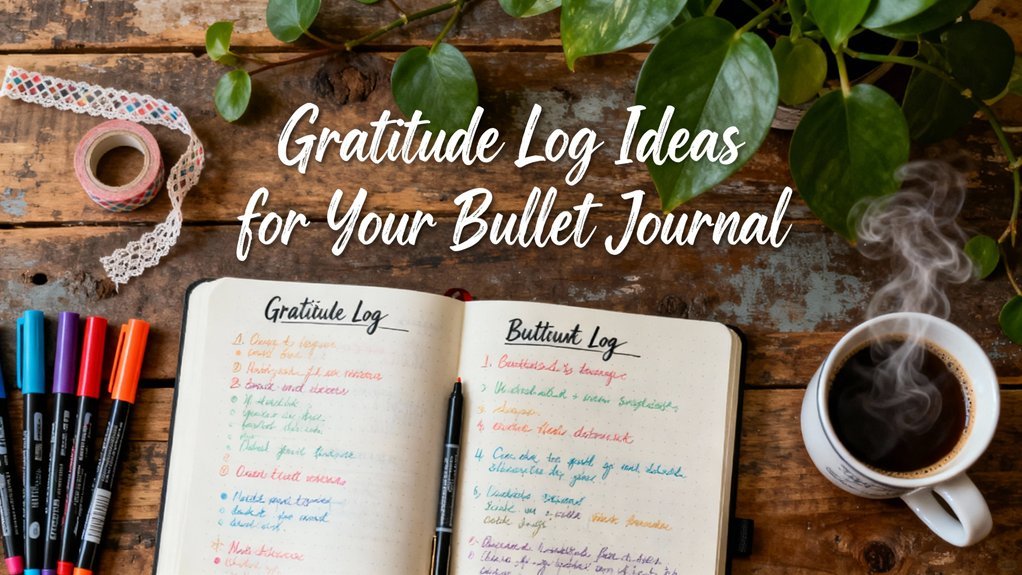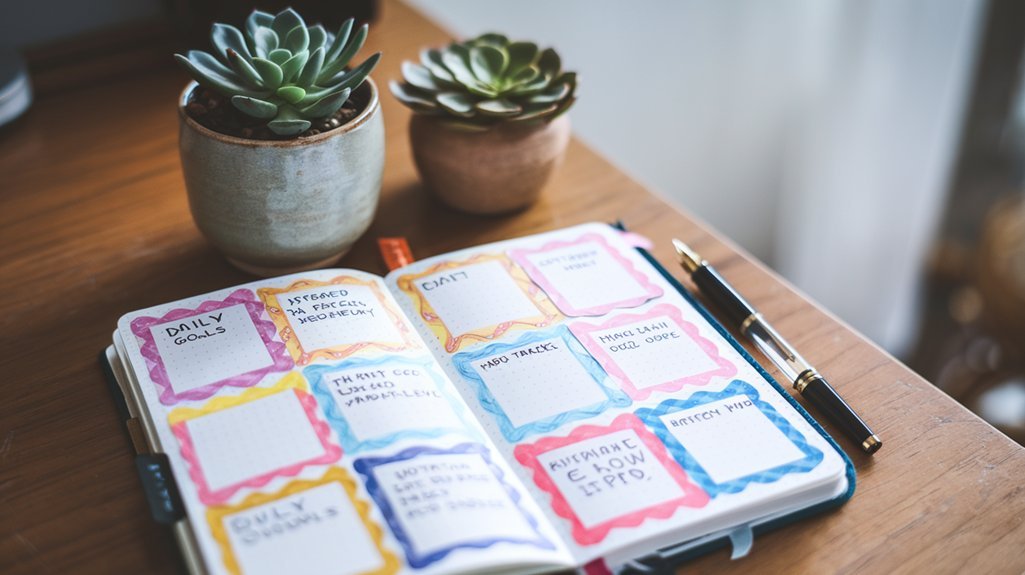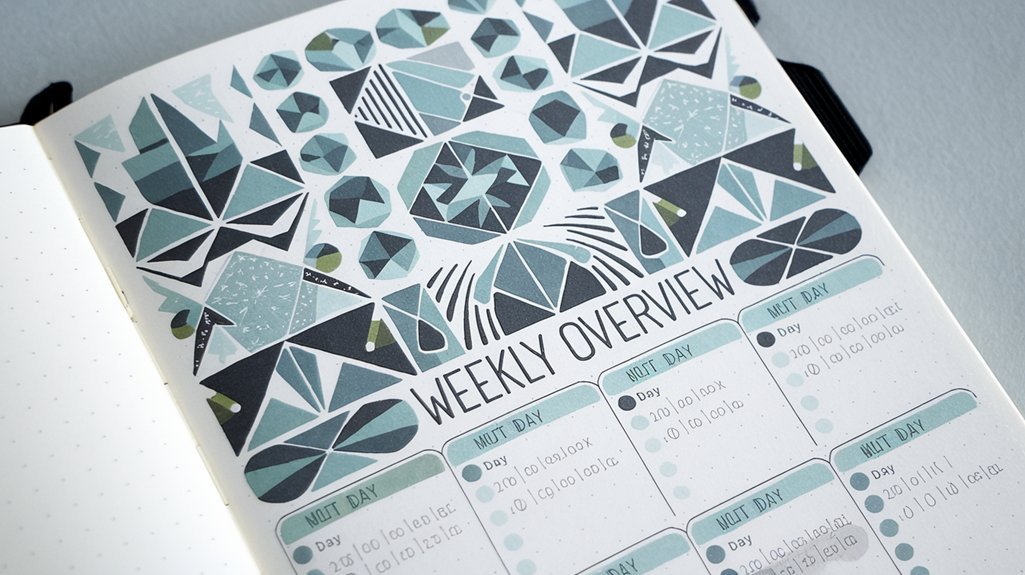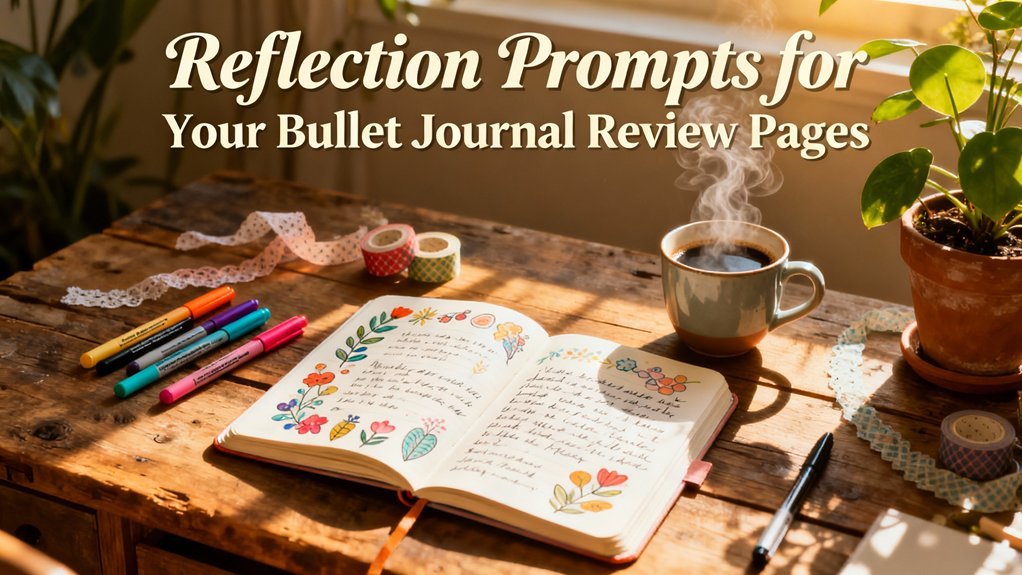Convert your bullet journal into a gratitude archive by mixing daily one-line trackers with themed weekly spreads and monthly calendar grids. You'll create visual patterns through color-coded entries, icon systems, and minimalist doodles that capture grateful moments. Strategic prompts like “What made you smile?” eliminate decision fatigue while deepening your reflections beyond surface-level lists. Typography hierarchy, botanical borders, and quote anchors turn simple entries into scannable stories that reveal emotional landscapes. The sections ahead showcase specific layouts that'll amplify your appreciation practice.
Key Takeaways
- Daily one-line trackers create year-long visual stories with color-coded themes and strategic prompts to eliminate decision fatigue.
- Weekly spreads rotate focus areas like relationships and growth, using themed sections, reflection prompts, and visual dividers.
- Monthly calendar grids capture single gratitude moments with typography hierarchy distinguishing milestones from daily observations.
- Visual logs use icon systems, emotional color coding, and minimalist doodles to create personalized symbols for recurring gratitudes.
- Prompted entries inject depth through sensory details, challenge reframes, people impacts, and micro-moment celebrations.
Daily One-Line Gratitude Trackers
When you're short on time but committed to daily reflection, a one-line gratitude tracker changes your bullet journal into a year-long visual narrative.
A one-line gratitude tracker transforms fleeting moments into a year-long visual story of appreciation and growth.
Design monthly spreads where single lines capture each day's moment of appreciation, creating a scannable archive of positivity.
Structure your tracker with strategic daily prompts that eliminate decision fatigue: “What made you smile?” on Mondays, “Who enriched your day?” on Wednesdays.
This framework accelerates your practice while maintaining depth.
Integrate gratitude quotes as visual anchors—position them as headers or margin elements that reinforce your intentions.
Choose typography that establishes clear hierarchies: bold prompts, flowing responses, accent quotes.
Color-code entries by theme (relationships, achievements, simple pleasures) to reveal patterns over time.
Your one-line format demands precision, altering vague appreciation into concrete observations.
This constraint breeds creativity, forcing you to distill experiences into their essential elements while building a compact, powerful gratitude ecosystem.
If you're new to bullet journaling, mastering time management techniques through simple trackers like these helps you build consistency before exploring more complex spreads.
Weekly Gratitude Spread Layouts
While daily one-liners build momentum through brevity, weekly spreads offer expansive canvases for deeper gratitude exploration.
You'll convert blank pages into intentional reflection spaces that balance aesthetic appeal with meaningful practice.
Design your weekly layouts around these structural elements:
- Themed sections that rotate focus areas—relationships, achievements, unexpected joys, personal growth, or sensory experiences
- Quote integration zones where gratitude quotes anchor your spread and inspire daily reflections
- Visual dividers using banners, borders, or geometric shapes to create distinct recording areas
- Photo pockets or sketch boxes for capturing grateful moments through imagery
- Reflection prompts positioned strategically to deepen your weekly themes beyond surface-level listing
Your weekly spreads become living documents that reveal gratitude patterns.
Dedicate Sundays to setup, establishing your theme and selecting quotes that'll resonate throughout the week.
This intentional architecture converts scattered appreciation into cohesive gratitude narratives you'll revisit repeatedly.
This practice helps clear mental clutter as you reconnect with what truly matters through intentional writing and reflection.
Monthly Gratitude Collection Pages

As weeks compound into thirty-day intervals, monthly collection pages change scattered gratitude entries into pattern-revealing archives that demand strategic organization.
Design calendar grids where each date houses a single gratitude moment, creating visual density that reveals frequency patterns. Alternatively, construct vertical timelines with expandable sections for high-gratitude days.
Monthly themes provide structural coherence—dedicate November to relationships, December to personal growth, January to professional wins. This thematic approach trains your attention toward specific life domains while preventing appreciation fatigue.
Integrate gratitude quotes as anchored design elements rather than decorative afterthoughts. Position them as section dividers or margin annotations that frame your entries with philosophical context.
Use typography hierarchy to distinguish between reflection types: bold headers for major milestones, minimalist scripts for daily observations.
Color-code recurring gratitude categories to spot trends instantly. Your monthly spreads become analytical tools, converting subjective thankfulness into quantifiable insight about what consistently enhances your existence.
Visual Gratitude Logs With Doodles and Illustrations
Beyond text-based documentation, illustration alters gratitude tracking from linguistic record-keeping into visual storytelling that engages different cognitive pathways.
Visual gratitude journaling activates multiple cognitive pathways, transforming simple written records into memorable artistic expressions that deepen emotional connection.
You'll discover that doodle inspiration changes mundane entries into memorable artistic expressions.
Implement these illustration techniques:
- Icon systems: Create personalized symbols representing recurring gratitudes—coffee cups for morning rituals, hearts for relationships, stars for achievements.
- Emotional color coding: Assign hues to gratitude categories, building chromatic patterns that reveal emotional landscapes over time.
- Minimalist line drawings: Frame brief text entries with simple sketches that capture essence without demanding extensive artistic skill.
- Composite scenes: Dedicate full pages to illustrated vignettes combining multiple gratitudes into cohesive visual narratives.
- Botanical borders: Incorporate floral elements and organic motifs that grow progressively throughout your journal.
Your visual approach doesn't require professional artistry—spontaneous mark-making and experimental layouts generate authentic documentation.
This methodology activates creative problem-solving while reinforcing positive memory formation through dual-coding theory.
Prompted Gratitude Journal Entries
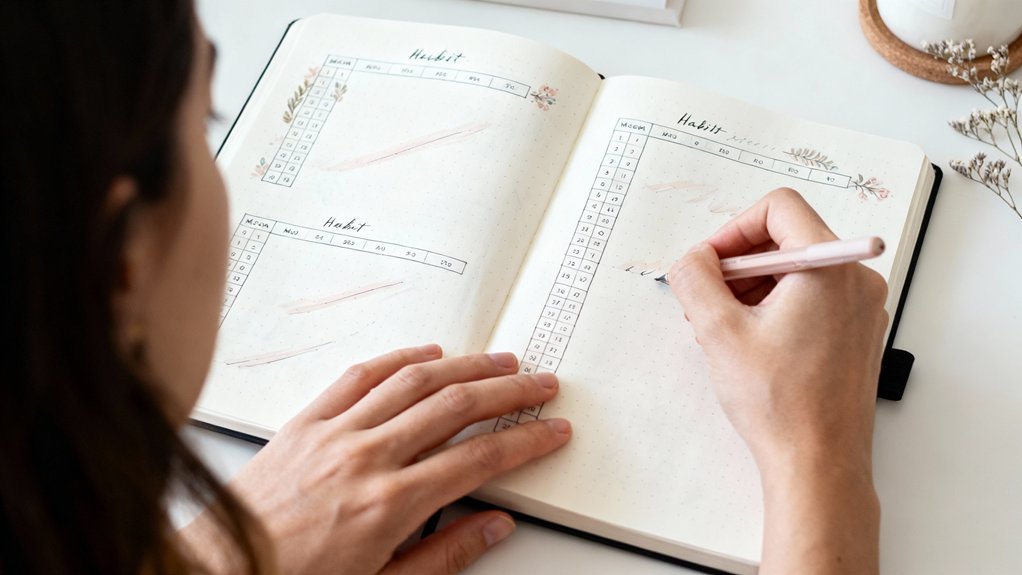
When your gratitude practice stagnates into mechanical repetition, strategic prompts inject specificity and depth into otherwise generic entries. Change blank pages into exploration territories using specific prompts that challenge surface-level responses and nurture meaningful reflection.
Structure your prompted entries with intentional creative themes that rotate weekly or monthly:
| Prompt Category | Example Question | Layout Style |
|---|---|---|
| Sensory Gratitude | What texture brought comfort today? | Bordered text box with small sketches |
| People Impact | Who taught you something unexpected? | Two-column split with names and lessons |
| Challenge Reframe | What difficulty revealed hidden strength? | Before/after comparison layout |
| Micro-moments | What 10-second interaction sparked joy? | Timeline format with timestamps |
Designate specific spreads for recurring creative themes: “Three Things Thursday” or “Surprise Saturdays.” Vary your prompt difficulty—some days demand introspection, others celebrate simple pleasures. This intentional variation prevents autopilot journaling while maintaining your gratitude momentum.
Frequently Asked Questions
What Time of Day Is Best for Writing Gratitude Entries?
You'll find morning reflections set a positive tone for your day ahead, while evening reviews help you process experiences with fresh perspective.
There's no single “ideal” time—experiment with both to discover what resonates with your rhythm.
Consider split-page layouts tracking morning intentions versus evening realizations, creating visual patterns that reveal your gratitude flow.
Your bullet journal becomes a living laboratory where you'll innovate your own prime practice through intentional design and authentic self-discovery.
How Does Gratitude Journaling Improve Mental Health and Wellbeing?
Gratitude journaling rewires your brain's neural pathways, strengthening emotional resilience through consistent positive focus.
Picture Sarah, who changed her anxiety by tracking three daily wins—her stress levels dropped 40% in eight weeks.
You'll access mindfulness benefits as your practice anchors you in present moments, shifting attention from what's missing to what's abundant.
This intentional awareness builds psychological flexibility, helping you bounce back faster from setbacks while cultivating lasting contentment through documented appreciation patterns.
What Should I Do When I Can't Think of Anything Grateful?
When you're stuck, turn to gratitude prompts that spark creative inspiration.
Design a visual brainstorming page with cascading question boxes: “What made me smile today?” or “Which small comfort did I overlook?”
Use color-coded sections and geometric frames to organize different prompt categories.
Create a rotating wheel of gratitude themes—senses, relationships, nature, achievements—that'll guide your exploration.
This structured-yet-flexible approach changes blank-page paralysis into a groundbreaking discovery system that consistently uncovers hidden appreciations.
Can Gratitude Journaling Help With Anxiety and Depression Symptoms?
You'll discover mindfulness benefits as gratitude journaling rewires your thought patterns, shifting focus from anxious spirals to positive observations.
It builds emotional resilience through consistent practice—training your brain to identify silver linings even during tough moments.
Design your spreads with intention: use color-coded mood trackers, layered text boxes, and strategic white space to visualize progress.
This isn't just therapeutic documentation; it's a groundbreaking mental health tool that changes scattered worries into structured, actionable self-awareness.
How Long Should I Maintain a Gratitude Practice to See Benefits?
You'll notice initial shifts within 2-3 weeks of daily consistency, but the real metamorphosis unfolds over 8-12 weeks of sustained practice.
Long-term benefits compound exponentially—your brain literally rewires itself through neuroplasticity.
Design your gratitude spreads with intentional visual cues that anchor the habit: color-coded mood trackers, progressive goal markers, and minimalist prompts.
Think of it as building mental architecture—each entry's a deliberate stroke in your cognitive masterpiece.
Conclusion
You'll discover that gratitude journaling truly changes your mindset—it's not just trendy aesthetics. Watch how your daily one-liners evolve into elaborate spreads, each page reflecting growth you didn't see coming. Your doodles become visual proof of joy; your collections reveal patterns of abundance. The theory holds: consistent gratitude tracking rewires your perspective. So grab those colorful pens and create spreads that aren't just pretty—they're functional mirrors of your most grateful self.

